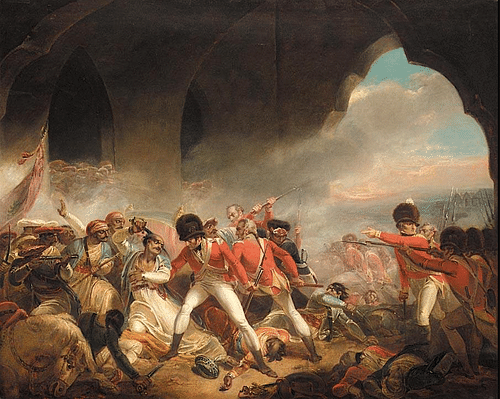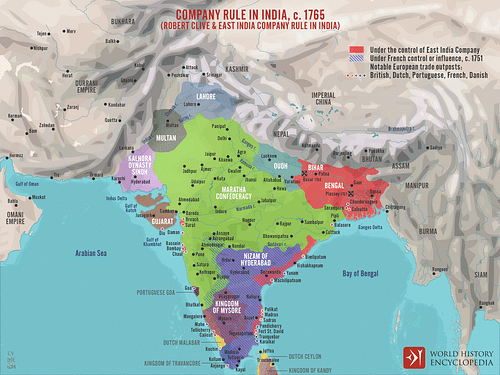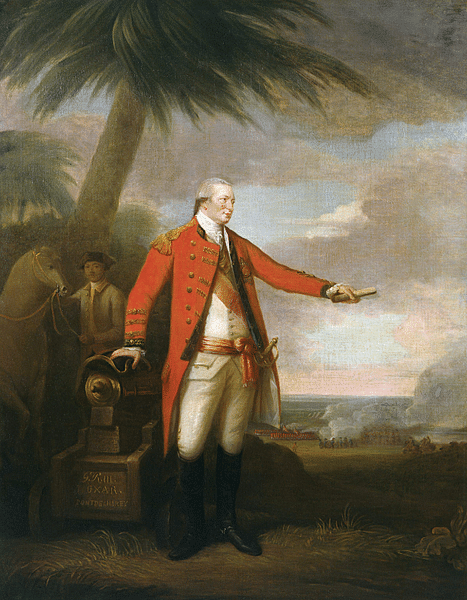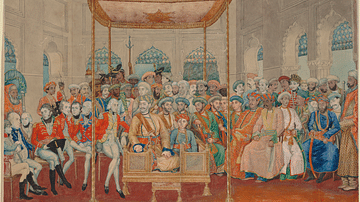
The Four Anglo-Mysore Wars (1767-1799) were fought between the British East India Company (EIC) and the state of Mysore. Haidar Ali and his son Tipu Sultan, the "Tiger of Mysore", were relentless foes to British expansion in southern India but were eventually subdued by the triple alliance of the EIC, the Maratha Confederacy, and the Nizam of Hyderabad.
The four Anglo-Mysore wars were spread over four decades of battles, sieges, and ruthless psychological warfare:
- First Anglo-Mysore War (1767-69)
- Second Anglo-Mysore War (1780-84)
- Third Anglo-Mysore War (1790-92)
- Fourth Anglo-Mysore War (1799)
East India Company Expansion
The East India Company was founded in 1600, and by the mid-18th century, it was benefiting from its trade monopoly in India to make its shareholders immensely rich. The Company was effectively the colonial arm of the British government in India, but it protected its interests using its own private army and hired troops from the regular British army. By the 1750s, the Company was keen to expand its trade network and begin a more active territorial control in the subcontinent.
Robert Clive (1725-1774) won a famous victory for the EIC against the ruler of Bengal, Nawab Siraj ud-Daulah (b. 1733) at the Battle of Plassey in June 1757. The Nawab was replaced by a puppet ruler, the state's massive treasury was confiscated, and the systematic exploitation of Bengal's resources and people began. 'Clive of India' was made the Governor of Bengal in February 1758 and, for a second spell, in 1764. The EIC won another key contest in October 1764. After victory at the Battle of Buxar (aka Bhaksar), the Mughal emperor Shah Alam II (r. 1760-1806) awarded the EIC the right to collect land revenue (dewani) in Bengal, Bihar, and Orissa. This was a major development and ensured the Company now had vast resources to expand and protect its traders, bases, armies, and ships. Unfortunately for the EIC, its growth meant that it came into conflict with new powers, chief amongst them the southern state of Mysore.

First Anglo-Mysore War
The ruler of Mysore was Haidar Ali (1721-1782), in power since 1761 when he usurped the throne and took over the royal palace in Seringapatam (Srirangapatna), the capital of the kingdom located on the Kaveri river. Ali, an experienced general, was keen to expand his kingdom which covered the southern portion of India, and he had the means to do it thanks to a series of revenue and tax reforms that permitted him to fund a large army. Another advantage for Mysore was innovations in weapons, particularly the use of handheld rockets, typically fired by cavalry riders.
The problem for Ali was that this part of the subcontinent was a particularly busy area of competing states. To the south was Travancore, in the northwest was the Maratha Confederacy (aka the Mahrattas, 1674-1818) – a loose confederation of Hindu princes, and to the northeast and east was the Nizam of Hyderabad. This part of India was also the main presence of the French East India Company, but they had been seriously squeezed by the increased militarism of the British East India Company, particularly along the eastern coast, often called the Carnatic coast. From the mid-1750s, the British had gained several important victories which gave them control of trade centres like Pondicherry and Arcot. Haidar Ali courted the French as allies, and while the EIC was seemingly busy expanding in Bengal in northeast India in the 1760s, Ali saw the opportunity to expand into the less powerful EIC presidency (administrative region) of Madras. In August 1767, he declared war on the East India Company. He had 50,000 well-trained and well-equipped troops, including camel cavalry that fired rockets, more and bigger cannons than the EIC, and superior logistics based on large permanent pens of bullocks for use as transportation (it took dozens of bullocks to move heavy cannons, for example).
When the EIC realised Madras was under serious threat and the directors saw with horror the consequent crash in the EIC's share price back in London, the company took decisive action. The EIC joined forces with the Nizam of Hyderabad to attack Mysore in 1767. Ali shrewdly pursued a scorched earth policy while buying off the Marathas with a huge quantity of silver. The withdrawal of the Marathas resulted in the Nizam of Hyderabad switching sides. Both were then defeated at the Battle of Trinamalai (September 1767) by an EIC army led by Colonel Joseph Smith. Hyderabad then switched sides again, but still, Haidar Ali fought on. Then another EIC force mobilised from Bombay (Mumbai) on the western coast.
Caught between three armies, Haidar Ali decided to sue for peace, one which the EIC was glad to accept given the already high costs of the war. Consequently, the First Anglo-Mysore War ended in an alliance between the EIC and Mysore with a mutual protection clause against any future threat from the Marathas. The Maratha Confederacy had challenged and conquered territories of the Mughal Empire in the southern and western areas of India through the 18th century and was perhaps the greatest threat to everyone else, but the Marathas were a group ravaged by internal disputes, which limited their effectiveness in wars. The Marathas would be on-off allies and outright enemies of the EIC through the three Anglo-Maratha Wars until the dominance of the British was finally established in 1819. As these various powers jostled for supremacy in southern India, the consequent disturbance to peasant life manifested itself in a terrible famine in 1770.
Second Anglo-Mysore War
The second round of warfare between Mysore and the EIC saw Haidar Ali invade the Carnatic coast to the east with a massive army of 70,000-100,000 men. Through 1780, many isolated British forts were captured and Madras came under serious threat again. Ali had at his disposal far more and bigger cannons than the British, and he was always careful to ensure local terrain protected his artillery in battles so that they could be whisked away if the infantry side of things went against him.
The British, largely due to poor planning and even poorer logistics, suffered a resounding defeat at the Battle of Pollilur in September 1780. The overall commander was Sir Hector Munro, victor at the famous Battle of Buxar in 1764, but Munro was long past his best, and, fatally, he had not managed to link up with a second EIC army led by Colonel William Baillie. It was Baillie's force which was destroyed at Pollilur despite brave resistance.
This defeat at Pollilur, which Munro described as "the severest blow that the English ever suffered in India" (Dalrymple, 255), was very damaging to the Company's reputation in the subcontinent. In addition, thousands of British soldiers were taken prisoner, "although many were later released, some converted to Islam, were given wives, and were incorporated into his [Ali's] army" (Barrow, 87). There were also tales of forced circumcisions, the smashing of limbs with hammers, and long spells in flooded cells for those British unfortunate enough to be captured.
At least the British domination of the High Seas meant that Mysore's traditional ally France was limited in how much logistical help it could give to the Indian kingdom. Eventually, the superior resources of the EIC and its ability to renew its armies and weaponry began to tell. The EIC won the Battle of Porto Novo (Parangipettai) in July 1781 thanks to its gifted commander Sir Eyre Coote (1726-1783). Coote had exploited the fact that Haidar Ali had unwisely left his left flank unprotected, thinking the sand hills in that position would suffice. Nevertheless, Mysore continued the war, concentrating now on sporadic attacks on the EIC supply network. Haidar Ali died of illness, possibly blood poisoning or cancer, in December 1782. Ali's son and successor, Tipu Sultan (aka Tipoo Sahib, r. 1782-1799), continued his father's aggressive expansionist policies, particularly against his southern neighbours of Cochin, Malabar, and Travancore. Tipu styled himself as the "Tiger of Mysore" in reference to his military prowess and the profusion of tigers then roaming southern India. Tipu went even further in the association and kept a menagerie of tigers in his palace and used the animal as a logo on everything from banners to his personal firearms; the sultan even had a mechanical tiger made for him (the contraption survived better than its owner and is today on public display in London's Victoria and Albert Museum).
The EIC won the Second Anglo-Mysore War after Tipu Sultan was obliged to sue for peace following the withdrawal of French naval support headed by Admiral de Suffren. The 1784 Treaty of Mangalore essentially restored the borders to the situation prior to the war.
Third Anglo-Mysore War
The EIC Governor-general from 1786 was Lord Charles Cornwallis (1738-1805), and he continued the company's policy of boxing in Mysore through alliances, ensuring the continued hostility of the Nizam of Hyderabad and the Maratha Confederacy against the southern kingdom. The lack of interest Tipu Sultan showed in cultivating allies would, in the end, be the main reason for his demise. The ongoing war also brought the British a new ally eager to defend its own boundaries with Mysore. This was the Kingdom of Travancore. The EIC was determined that Travancore would not be gobbled up by Mysore. In addition, the EIC was equally determined that they would smash the Mysore-France alliance that military intelligence revealed involved shipments of French arms to southern India via Mauritius. Even more useful to Tipu Sultan was the few hundred French mercenaries who not only fought for him but helped train his army and improve his weapons manufacturing, albeit on a small scale.
When Tipu Sultan attacked Travancore on 29 December 1789, the various alliance treaties kicked into gear and the Third Anglo-Mysore War began. In December 1790, Mysore attacked the Carnatic coast again where towns, villages, and temples were razed to the ground.

An EIC army of 19,000 sepoys led in person by Cornwallis first took Mysore's second city of Bangalore and then linked up with his Hyderabad allies, who came in the form of 18,000 cavalry. Cornwallis struggled to find supplies in the face of Tipu Sultan's familiar scorched earth tactics, but he was further reinforced by a Maratha army of 12,000 men. This combined force eventually moved to besiege Seringapatam. Tipu's Sultan's fortress capital was a formidable nut to crack as it had been designed by French engineers using the very latest ideas on how to resist artillery and mining. Sustained barrages and attacks did eventually persuade Tipu Sultan to surrender in January 1792. The terms of the Treaty of Seringapatam were harsh: Tipu Sultan was obliged to give up a large slice of his kingdom, pay the EIC regular 'protection' money, release all prisoners, and leave two of his sons with the Company as hostages. At least the Mysore ruler lived to fight another day, or rather, another war.
Fourth Anglo-Mysore War
The fourth and final installment of this round of on-off wars to control southern India saw Tipu Sultan once more form an alliance with the French. Tipu Sultan had even written to Napoleon Bonaparte (1769-1821) to send him an army, but the future emperor had already set his sights on Egypt as the stage to best attack British interests abroad. Back in India, the EIC was determined to break such a potentially threatening alliance, and Lord Richard Colley Wellesley (1760-1842), the new EIC Governor-General (appointed 1798), was the most aggressive governor yet. Wellesley amassed a massive army to quash Mysore once and for all. Wellesley also had the continued backing of the Maratha Confederacy and the Nizam of Hyderabad whose army was led by Arthur Wellesley (future Duke of Wellington and victor at Waterloo). There was, too, an elite battalion of 1,400 British Army grenadiers and a battalion of Scottish Highlanders. As the EIC assembled its most powerful pieces for this final round in the four-decade game of empires, the situation for Mysore looked bleak indeed. By February 1799, 50,000 fighting men were on the march to once again attack Seringapatam.
On 7 April 1799, the EIC army led by Major-General David Baird (a one-time prisoner of Tipu Sultan) along with his Indian allies, began a one-month siege of fortress Seringapatam. By 2 May, the 40 massive 18-pound cannons of the attackers – brought to the capital for this specific purpose – had at last blasted enough holes in the formidable fortification walls to permit the infantry to storm the city and win the war. A staggering 927 cannons were captured at Seringapatam fortress, ten times more than the British had. Tipu Sultan was killed in action or its immediate aftermath, and his remaining family members were exiled. 10,000 men on the Mysore side had been killed compared to just 350 or so of the attackers. The city was systematically looted, and for 24 hours, its 100,000 civilians suffered the unspeakable terrors of those left to face an out-of-control victorious army.

Mysore signed a treaty with the EIC in 1799, and the state, now much reduced in territory, came under British rule through their reinstallation of a puppet ruler, Krishna Raja Wadiyar III of the traditional Wadiyar ruling family (which had reigned before Haidar Ali's takeover). The British took over Mysore directly in 1831. Victory over Mysore had, for the EIC, "removed a bogey which had overshadowed all their activities in South India for thirty years" (Spear, 102). The storming of Seringapatam marked the first occasion the EIC issued medals to all ranks in its armies, ranging from solid gold medals for a general to tin versions for privates, British and Indian.
Aftermath
While the EIC showed the subcontinent the eventual fate of any kingdom that dared to cross it, the spectre of Tipu Sultan cast a long shadow over the British psyche. Rarely had the EIC come across such a determined foe, and Tipu was demonized in Britain, so much so, Indians in Britain frequently had to bear children in the street shouting at them "Tipoo, Tipoo!". The four Anglo-Mysore Wars became the stuff of legend and were a favourite subject for London playwrights in the 19th century, while Tipu Sultan's demise captured the imagination of countless painters and engravers. More recently, Tipu Sultan's reign and character have been more carefully re-examined by historians, and the study of, for example, temple records shows that he was a generous benefactor to Hindu shrines. We also now know that he possessed a library of 2,000 books and was a keen collector of the latest scientific instruments. The Mysore ruler was certainly guilty of devising gruesome deaths for his captives, but he is nowadays presented less as a Muslim fanatic intent on murdering Hindus and Europeans alike and more as an industrious administrator, enlightened ruler, and gifted general who was, in the end, the victim of the relentless colonial expansion of his more powerful neighbours.







